Even a small water feature can be home to a diverse range of wildlife, including damsel and dragonflies, frogs, and newts. Urban gardeners are increasingly turning to compact pond designs to bring life to their outdoor spaces.
Water features like these not only attract birds, insects, and other creatures but also provide a calming element that can benefit our mental health. By incorporating a small pond into your garden, you can create a peaceful oasis that enhances your outdoor living experience.
Key Takeaways
- Small ponds can support a variety of wildlife.
- Compact pond designs are trending among urban gardeners.
- Water features can enhance mental well-being.
- Small ponds can be a calming element in outdoor spaces.
- Creating a small pond can be a rewarding gardening project.
The Magic of Water Features in Small Spaces
Incorporating a water feature into your small garden can be a game-changer, transforming it into a serene oasis. Modern research has shown that blue spaces, such as water features, are hugely beneficial to our mental health.
Benefits of Adding a Tiny Pond to Your Garden
Adding a tiny pond to your garden can have numerous benefits, ranging from mental health improvements to environmental advantages.
Mental Health and Relaxation Benefits
The sound of gently flowing water can be incredibly soothing, creating a peaceful ambiance that helps reduce stress and promote relaxation. Studies have shown that being near water can improve mental health and overall well-being.
Environmental Advantages
A tiny pond can also provide a habitat for various forms of wildlife, such as birds, insects, and even small fish. This can enhance biodiversity in your garden, contributing to a healthier ecosystem.
How Water Features Transform Garden Ambiance
Water features can dramatically transform the ambiance of a garden, making it feel more tranquil and inviting. Some key ways they achieve this include:
- Creating soothing sounds that mask background noise
- Providing a visually appealing focal point
- Attracting wildlife, adding to the garden’s dynamic nature
By incorporating a small backyard pond design or miniature water feature, you can create a more engaging and peaceful outdoor space.
Tiny Pond Ideas for Small Gardens: Finding Your Perfect Style
Even the most compact outdoor spaces can be enhanced with creative tiny pond designs. For small spaces and balconies, a pond bucket is an ideal way to easily create a pond for wildlife, adding a soothing element to your garden.
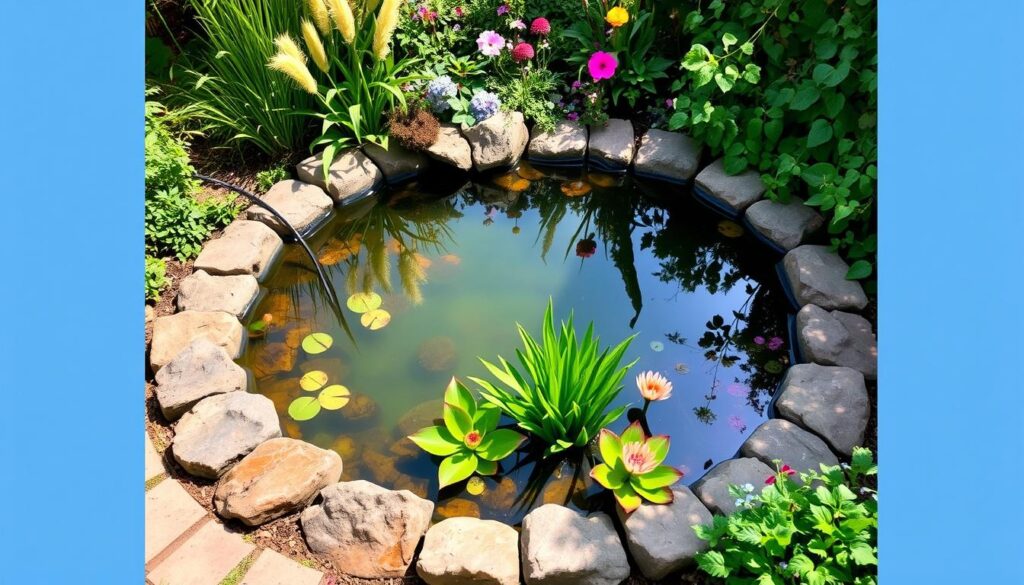
Container Ponds for Ultra-Small Spaces
Container ponds are perfect for ultra-small spaces, allowing you to create a mini oasis on your balcony, patio, or even indoors. Use a large container or tub and fill it with water, adding aquatic plants and possibly a small pump to create movement.
Tips for container ponds: Choose a container that is at least 12-18 inches deep to support plant life. Consider using a pre-formed pond liner or a waterproof membrane to prevent leaks.
In-Ground Mini Ponds
In-ground mini ponds can be a beautiful addition to small gardens, providing a naturalistic water feature that attracts wildlife. Even a small, shallow pond can become a focal point in your garden.
Key considerations: Ensure the pond is positioned in a spot that receives partial shade to prevent excessive algae growth. Use a liner to protect the surrounding soil and plants.
Patio and Deck Water Features
Patio and deck water features offer a versatile way to incorporate the soothing sound of water into your outdoor living space. From small fountains to mini ponds, these features can enhance the ambiance of your garden.
When designing a patio or deck water feature, consider the scale of your space and choose a feature that complements it. A small, self-contained fountain can be a great addition to a compact patio.
Essential Materials and Tools for Your Tiny Pond Project
To bring your tiny water garden design to life, you’ll need to gather essential supplies. A well-planned tiny pond project requires careful selection of materials and tools to ensure its longevity and aesthetic appeal.
Liner Options for Small Ponds
The liner is a crucial component of your tiny pond, preventing leaks and ensuring that your water feature remains functional. You can choose from various liner materials, including rubber, PVC, and EPDM. Rubber liners are durable and flexible, while PVC liners are more affordable but less durable. EPDM liners offer a good balance between durability and cost.
Pumps and Filters for Miniature Water Features
A pump is necessary for circulating water and maintaining oxygen levels in your tiny pond. When selecting a pump, consider the size of your pond and the desired water flow. Filters help keep the water clean by removing debris and excess nutrients. You can choose from mechanical, biological, or a combination of both types of filters.
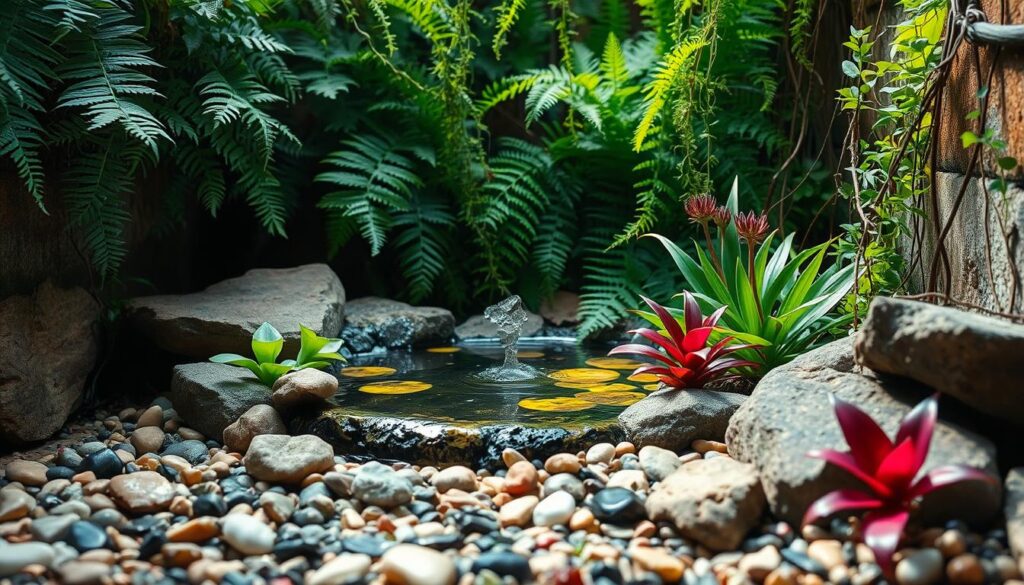
Decorative Elements: Rocks, Pebbles, and Ornaments
Decorative elements can enhance the visual appeal of your tiny pond. Rocks and pebbles can be used to create a natural-looking surround, while ornaments can add a personal touch. Consider using aquatic plants, such as water lilies or cattails, to add color and texture to your pond.
As you plan your tiny pond, remember to include essential materials like a mini-pump for circulation, aquatic compost, and gravel to create a thriving ecosystem. With the right materials and tools, you can create a beautiful and serene tiny water garden design that brings joy and tranquility to your outdoor space.
Step-by-Step Guide to Building Your Small Garden Pond
Creating a small garden pond can be a rewarding DIY project that enhances your outdoor space. With creative small pond ideas, you can transform even the tiniest garden into a serene oasis.
Planning and Site Preparation
Before you start digging, it’s essential to plan and prepare the site for your pond. This involves choosing the perfect location and measuring the area.
Choosing the Perfect Location
Select a spot that is partially shaded to prevent excessive algae growth. Ensure it’s also close to a power source if you plan to install a pump or other equipment.
Measuring and Marking Your Pond Area
Use a rope or hose to mark out the shape of your pond. Measure the area to determine the size of the liner you’ll need.
Installation Process
The installation process involves several key steps, from digging and shaping to liner installation and adding water and equipment.
Digging and Shaping
Start by digging the pond to the desired depth, using a shovel or spade. Create shelves for marginal plants if desired.
Liner Installation
Place the liner in the pond, ensuring it’s smooth and evenly spread. Use rocks or sandbags to hold it in place.
Adding Water and Equipment
Fill the pond with water, and install any pumps, filters, or other equipment according to the manufacturer’s instructions.
Finishing Touches
Once the pond is installed, you can add decorative elements such as rocks, pebbles, and ornaments to enhance its appearance.
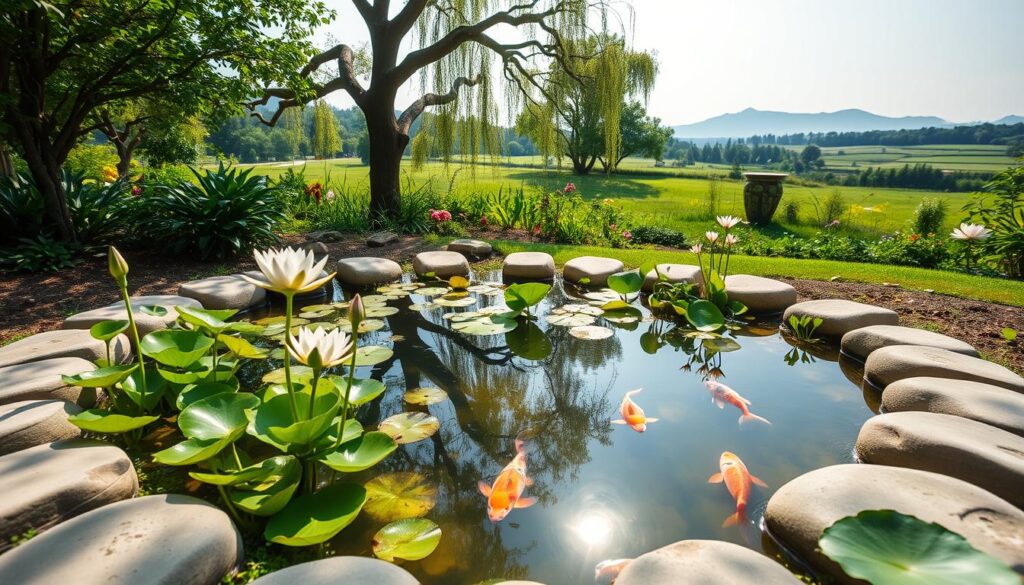
With these creative small pond ideas, you can create a beautiful and tranquil water feature in your small garden.
Creative Container Pond Projects for Tiny Gardens
Container ponds offer a versatile solution for creating miniature water features in tiny gardens. The beauty of using containers lies in their flexibility and the wide range of materials that can be repurposed.
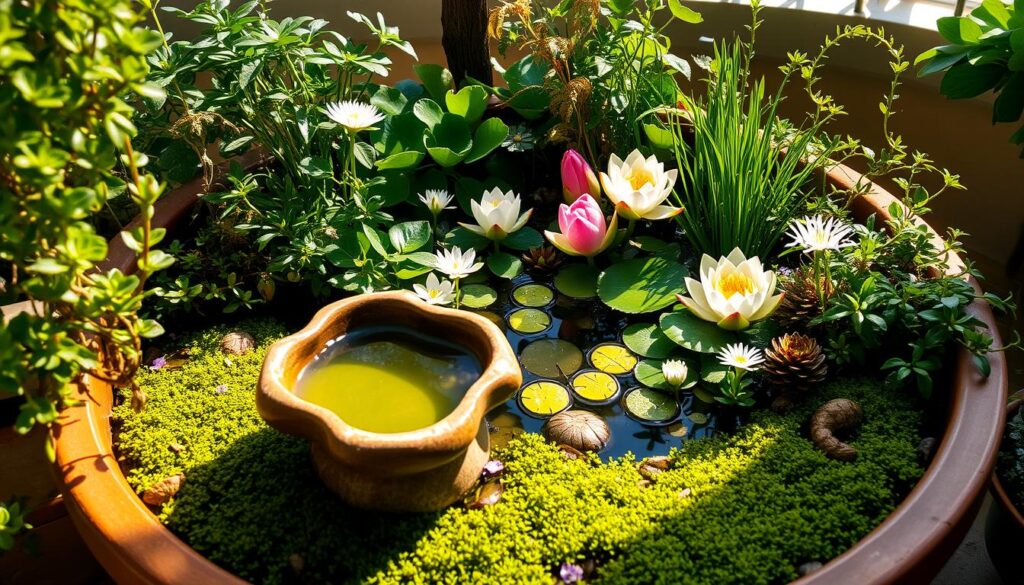
Repurposed Items as Unique Pond Containers
Almost any container that can hold water can be turned into a pond. This opens up a world of creative possibilities for gardeners looking to add a water feature to their small space.
Whiskey Barrels and Wooden Containers
Whiskey barrels and wooden containers make excellent pond containers. They add a rustic charm to the garden and can be easily adapted to fit small spaces. Ensure the wood is properly sealed to prevent leakage and extend the lifespan of your container pond.
Ceramic Pots and Vintage Bathtubs
Ceramic pots and vintage bathtubs are other unique options for container ponds. They come in various sizes and can add a touch of elegance or whimsy to the garden. When using ceramic pots, it’s essential to check for drainage holes and seal them if necessary.
Balcony-Friendly Miniature Water Gardens
For those with balconies, miniature water gardens can be a wonderful addition. These small water features can be created using compact containers and plants that thrive in smaller spaces. Consider using self-contained water features that have built-in pumps and filters for ease of maintenance.
Tabletop Water Features
Tabletop water features are another creative way to enjoy the soothing sounds of water in a small garden or indoor space. These compact systems are perfect for areas where space is extremely limited. They can be placed on patios, decks, or even indoors, bringing a sense of tranquility to any setting.
By exploring these creative container pond projects, you can find the perfect fit for your tiny garden, enhancing its beauty and creating a peaceful oasis.
Best Plants for Small Water Gardens
Incorporating plants into your small water garden not only adds visual appeal but also contributes to a healthier ecosystem. Plants play a crucial role in maintaining water quality, providing shade, and creating habitats for various aquatic life. When designing a small backyard pond design, the choice of plants is as important as the pond itself.
Selecting the right plants involves considering factors such as the size of your pond, the amount of sunlight it receives, and the climate in your area. Using plants with contrasting shapes can create appealing compositions, adding depth and visual interest to your water garden.
Floating Aquatic Plants for Tiny Ponds
Floating aquatic plants are a great addition to small water gardens. They help in shading the water, reducing algae growth, and providing shelter for fish. Some popular floating plants include:
- Water Lilies: These are perhaps the most iconic pond plants, offering beautiful flowers and large leaves that provide shade.
- Duckweed: A fast-growing plant that can help cover the surface of the water, though it may require regular thinning.
- Water Hyacinth: With its beautiful purple flowers, this plant is not only aesthetically pleasing but also effective at absorbing excess nutrients.
These plants are relatively low maintenance and can thrive in small ponds with proper care.
Marginal Plants for Pond Edges
Marginal plants, which grow in the shallow water around the edges of ponds, are essential for creating a natural transition between water and land. They help stabilize the pond’s edges and provide additional habitat for wildlife. Some excellent choices for marginal plants include:
| Plant | Description | Benefits |
|---|---|---|
| Iris | Produces beautiful flowers in various colors | Attracts pollinators and adds color |
| Cattail | Tall, distinctive plant with cylindrical flowers | Provides shelter for wildlife and helps stabilize pond edges |
| Pickerelweed | Produces blue or purple flowers | Attracts beneficial insects and adds to biodiversity |
As one expert notes, “A well-planted pond edge can significantly enhance the overall appearance and ecological value of your water garden.”
“A well-planted pond edge can significantly enhance the overall appearance and ecological value of your water garden.”
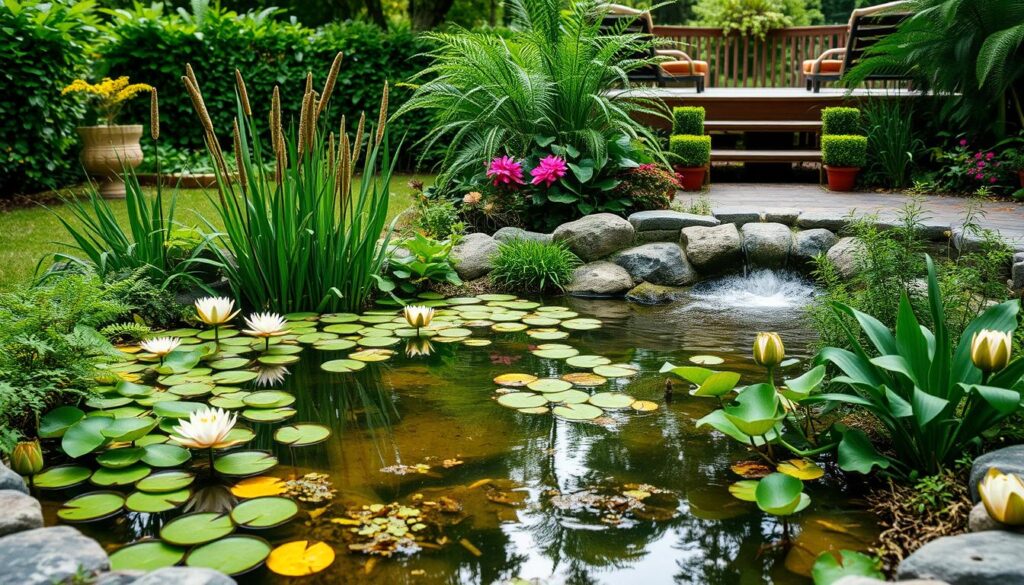
By incorporating a mix of floating aquatic plants and marginal plants, you can create a balanced and thriving ecosystem in your small water garden.
Attracting Wildlife to Your Small Pond
Even the smallest pond can be a haven for a surprising range of wildlife, from dragonflies to birds. By designing your tiny pond with wildlife in mind, you can create a thriving mini-ecosystem right in your backyard.
Creating a Habitat for Beneficial Insects
Beneficial insects such as dragonflies and damselflies are not only fascinating to watch but also help control mosquito populations. To attract these insects, incorporate native plants around your pond, especially those with flat leaves or stems where they can perch. Native vegetation is crucial as it provides shelter and breeding grounds for these beneficial creatures.
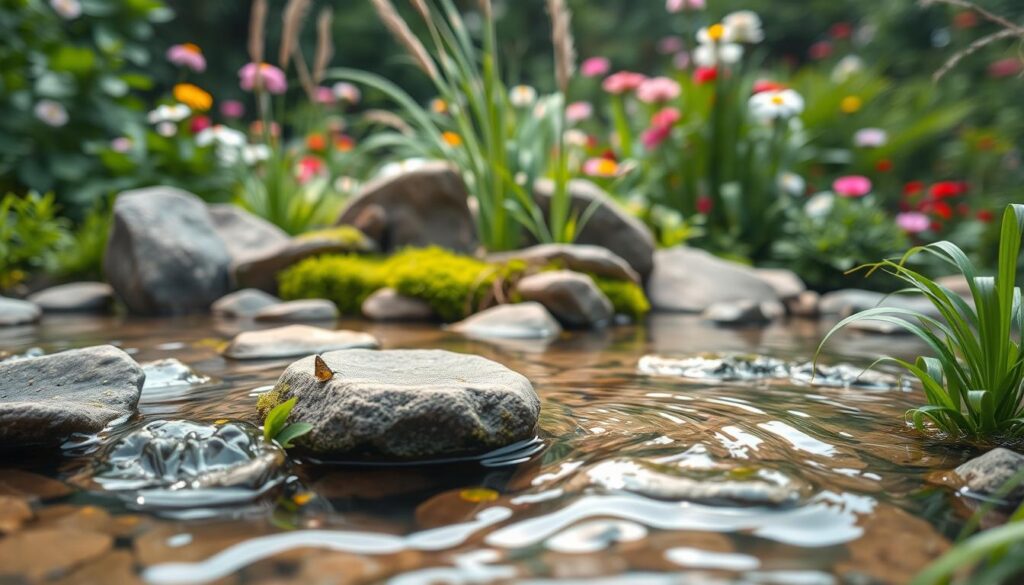
Fish Options for Tiny Ponds
When it comes to stocking your small pond with fish, it’s essential to choose species that are well-suited to the size and conditions of your pond.
Goldfish and Minnows
Goldfish and minnows are popular choices for small ponds due to their hardiness and relatively small size. They add movement and interest to your pond, and can thrive in well-oxygenated water.
Mosquito Fish and Other Small Species
Mosquito fish are another excellent option as they feed on mosquito larvae, helping to control pest populations. Other small fish species can also be considered, provided they are compatible with your pond’s conditions.
Bird-Friendly Water Feature Design
To attract birds to your pond, consider incorporating shallow areas where they can wade and drink. Adding a few rocks or branches for perching can also make your pond more inviting to birds. Bird-friendly design not only enhances the visual appeal of your garden but also supports local bird populations.
Seasonal Care and Maintenance for Mini Ponds
The changing seasons bring different challenges for mini pond owners, but with the right care, your compact garden pond projects can flourish year-round. As the seasons shift, so do the needs of your pond, requiring adjustments in maintenance and care to keep it a serene and thriving oasis.
Spring and Summer Upkeep
During spring and summer, your mini pond is in its active growing phase. Regularly check the water level and top it off as necessary due to evaporation. Clean the pond by removing debris and algae. It’s also crucial to monitor the health of your plants and fish, ensuring they’re thriving in the warmer temperatures.
Fall Preparation
As fall approaches, prepare your mini pond for the cooler months by removing dead plant material and reducing the amount of debris that can decay and affect water quality. Consider adding a net to catch falling leaves before they enter the water. This is also a good time to trim back plants and start thinking about protecting your pond for the winter.
Winter Protection for Small Water Features
Winter care is crucial to protect your mini pond from freezing temperatures.
Preventing Freezing Damage
Use a pond heater or a floating de-icer to keep a portion of the pond surface ice-free, allowing toxic gases to escape.
Caring for Plants and Fish in Cold Weather
For areas with harsh winters, consider bringing sensitive plants indoors or to a protected area. Fish can survive in cold water, but their metabolism slows down. Ensure they have enough food and oxygen.
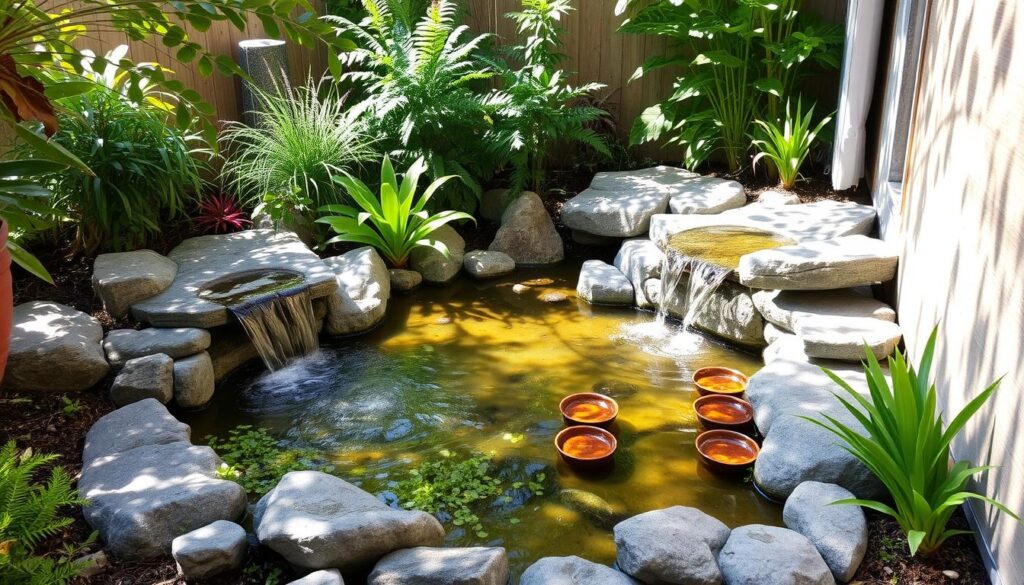
Troubleshooting Common Small Pond Problems
Despite the many benefits of having a small pond, there are several common problems that can arise, requiring prompt attention and resolution. These issues can impact the overall health and aesthetic of your tiny water garden, making it essential to identify and address them promptly.
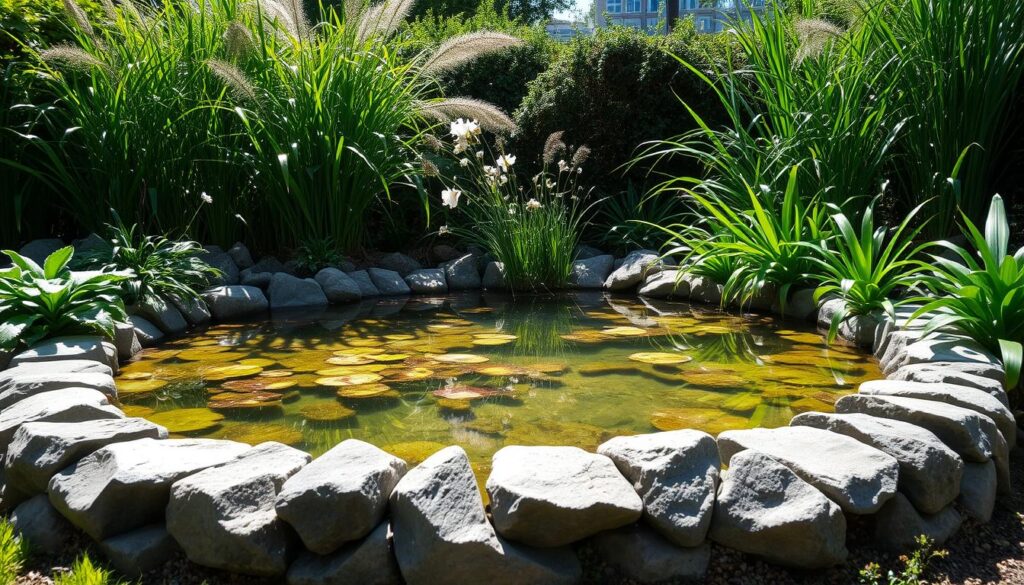
Dealing with Algae in Miniature Ponds
Algae growth is a common issue in small ponds, often caused by excess nutrients in the water. To combat this, it’s essential to maintain a balanced ecosystem by incorporating submerged plants, floating plants, and marginal plants to add oxygen to the water and reduce nutrient levels.
As noted by water gardening experts, “if you eschew a pump, you’ll need to include lots of submerged plants, floating plants, and marginal plants to add oxygen to the water.” This approach not only helps control algae but also creates a thriving ecosystem in your tiny water garden design.
Water Quality Issues and Solutions
Poor water quality can be detrimental to the health of your small pond’s ecosystem. Regular water testing is crucial to identify any imbalances, and adjustments can be made by performing partial water changes or adding beneficial bacteria to improve water quality.
Maintaining optimal water quality is vital for the well-being of your pond’s inhabitants. By monitoring water parameters and making necessary adjustments, you can ensure a healthy environment for your plants and animals to thrive.
Pond Liner and Equipment Maintenance
Regular maintenance of your pond liner and equipment is vital to prevent leaks and ensure the overall health of your small pond. Inspect the liner regularly for signs of damage or wear, and replace it if necessary.
Additionally, cleaning and maintaining your pond equipment, such as pumps and filters, will help prevent malfunctions and keep your pond running smoothly. By staying on top of maintenance, you can enjoy a beautiful and thriving diy small pond landscaping project.
Conclusion: Creating Your Own Backyard Oasis
Transforming your small garden into a serene oasis is now within reach, thanks to the numerous creative small pond ideas and minimalist pond designs for small spaces explored in this article. By incorporating a tiny pond, you can elevate your outdoor space’s ambiance and create a haven for relaxation and wildlife.
From container ponds to in-ground mini ponds, the possibilities are endless. As you’ve seen, with the right materials, tools, and plants, you can bring your vision to life. Whether you’re looking to attract beneficial insects, enjoy the soothing sound of water, or simply enhance your garden’s aesthetic, a small pond can be a game-changer.
Now that you’ve discovered the magic of tiny ponds, don’t be afraid to experiment and make it your own. Start small, be creative, and enjoy the journey of creating your own backyard oasis. Once you’ve mastered a small container, think about what you can achieve with a bigger water garden – the possibilities are truly exciting.



